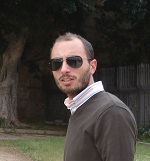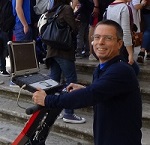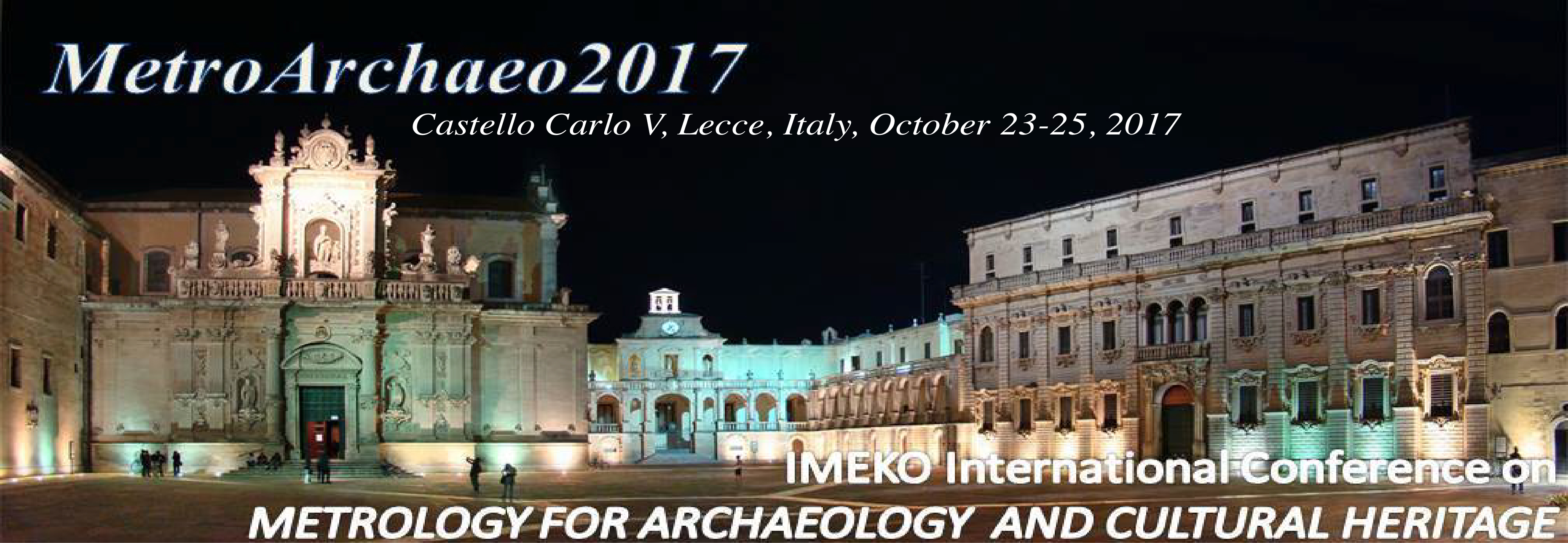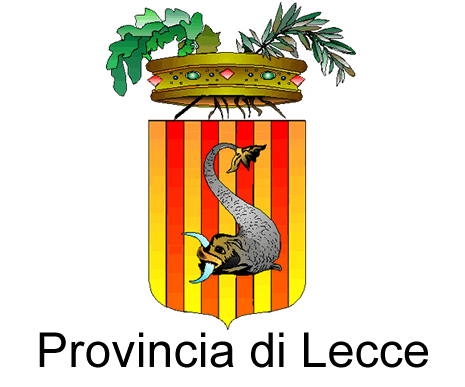Multidisciplinary approach in archaeological and cultural heritage science
ORGANIZERS
 Giuseppe Cacciaguerra
Giuseppe Cacciaguerra
IBAM-CNR sede di Catania
email: Questo indirizzo email è protetto dagli spambots. È necessario abilitare JavaScript per vederlo.
GIUSEPPE CACCIAGUERRA, actually is Researcher at Institute for Archaeological and Monumental Heritage - CNR (Istituto per i Beni Archeologici e Monumentali – Consiglio Nazionale delle Ricerche). He achieved the Ph.D. in “Humanities and Cultural Heritage” at the University of Catania, graduated in Classics and Archaeology at the same University and achieved his diploma of School of Archaeology at the University of Salento (Lecce). He taught in numerous university masters and is an expert teacher of «Metodologie, cultura materiale e produzioni artigianali nel mondo classico» at University of Catania and teach «Medieval Archaeology» at Uninettuno University (Rome). He coordinates the italian-belgian Joint Laboratory Project «ROMA» (Roman baths archaeological, cOnservation and heritage MAnagement) and coordinates the IBAM-CNR archaeological research in Valle dell'Aci and Catania within the project “NEPTIS” (ICT based solutions for augmented fruition and exploration of Cultural Heritage). In 2015 he coordinated IBAM-CNR research within the «PROVACI» Project in order to develope sustainaible methodologies and techniques for the seismic protection, valorization and fruition of cultural heritage masonry buildings and archeological site of Occhiolà (Catania). He was a reserarch fellow within the IBAM-CNR projects «Science & Technology Digital Library» and «Landscape Archaeology in Priolo Gargallo territory». He worked on the project «Roman Sicily Project: Ceramics and Trade» in order to create a database of roman ceramics and participated in the Research Unit for the project “Problemi archeologici e archeometrici nelle importazioni di ceramiche africane nella Sicilia romana, vandala e bizantina. Status quaestionis, metodologie e percorsi di indagine”, within the framework of scientific cooperation between the IBAM-CNR and the CCJ-CNRS. Since 2010 he works with a French Mission at Megara Hyblaea (Augusta, SR). He has participated in numerous excavations and research in the Mediterranean Countries (Italy, Cyprus, Turkey, Albania). He has 57 scientific pubblications (monographs and papers) on Landscape Archaeology, Urban Archeology, Roman and Medieval Archaeology, Roman and Medieval Material Culture and Cultural Heritage Management GIS based. He is actually coordinating archaeological research project in Roman and Medieval Sicily within a Mediterranean framework. References: - G. Cacciaguerra, D. Malfitana, Archeologia classica in Sicilia e nel Mediterraneo. Didattica e ricerca nell’esperienza mista CNR e Università. Il contributo delle giovani generazioni. Un triennio di ricerche e tesi universitarie, IBAM-CNR, Catania, 2014 (ISBN(13): 978-88-89375-12-9). - G. Cacciaguerra, D. Malfitana (a cura di), Priolo romana, tardo romana e medievale. Documenti, paesaggi, cultura materiale, I, IBAM-CNR, Catania 2011 (ISBN: 978-88-89375-07-5). - D. Malfitana, E. Shehi, G. Leucci, G. Cacciaguerra, N. Masini, G. Scardozzi, G. Fragalà, C. Santagati, The potential of integrated GPR survey and aerial photographic analysis of historic urban areas: A case study and digital reconstruction of a Late Roman villa in Durrës (Albania), in Journal of Archaeological Science, 4, 2015, pp. 276-284 (ISSN: 0305-4403). - D. Malfitana, G. Cacciaguerra, S. Barone, A. Mazzaglia, V. Noti, G. Leucci, L. De Giorgi, A. Cannata, C. Pantellaro, M.L. Scrofani, OPENCiTy Project: un progetto per l’archeologia urbana, la pèianificazionee lo sviluppo sostenibile di Catania. La valutazione del potenziale archeologico: primi dati, in MAPPA Data Book 1. I dati dell’archeologia urbana italiana, a cura di F. Anichini, G. Gattiglia, M.L. Gualandi, Roma, pp. 17-38 (ISBN 9788868125233). - D. Malfitana, G. Cacciaguerra, A. Branca, A. Cannata, C. Pantellaro, L. Carilli, Archeologia della produzione ceramica nella Sicilia ellenistica e romana. Primi dati dal quartiere artigianale di Siracusa, in HEROM, Journal on Hellenistic and Roman Material Culture, 4.2, 2015, pp. 222-275 (ISSN: 2294-4273).
 Giovanni Leucci
Giovanni Leucci
CNR-IBAM UOS di Lecce
email: Questo indirizzo email è protetto dagli spambots. È necessario abilitare JavaScript per vederlo.
Giovanni Leucci He is scientific director of the laboratory of geophysics applied to archaeology and monumental heritage. His research interests include geophysics applied in archeology, geology, non-invasive diagnostics of monumental heritage, engineering, environment. He has participated in numerous archaeo-geophysics campaigns in prestigious archaeological sites (Petra-Jordan, Hierapolis and Sagalassos - Turkey, Durres-Albany, the Roman ships of Pisa, Tindari, Ventarrón-Peru etc.) and he was invited professor at the Denver University (USA). He has received several international awards related to the quality of research and scientific production: University of Iceland (Geophysical Research Award), Journal of Geophysics and Engineering Best Paper Award. He is scientific point of reference for: 1) The IUGS and UNESCO for the evaluation of candidate sites to the inclusion in the World Heritage list; 2) the National Research Council of Romania, the German Research Foundation, the Czech Research Foundation, the Agency for Science and Higher Education of ENQA (European Association for Quality Assurance in Higher Education) of the Croatian Government for the evaluation of national and international research projects.
 Antonino Mazzaglia
Antonino Mazzaglia
IBAM-CNR sede di Catania
email: Questo indirizzo email è protetto dagli spambots. È necessario abilitare JavaScript per vederlo.
ANTONINO MAZZAGLIA, actually is Ph.D. student in “Humanities and Cultural Heritage” at the University of Catania, graduated in Classics and Archaeology at the same University and achieved his diploma of School of Archaeology at the Cattolica University of Milan. He is also a higher technician for informatical applications of cultural, natural and environmental heritage management (IV level in the EQF classification) and expert in GIS applications. He is associated to the Institute for Archaeological and Monumental Heritage - CNR (Istituto per i Beni Archeologici e Monumentali – Consiglio Nazionale delle Ricerche), and he takes part in many research projects of this Institute. He coordinates the multidisciplinar team of the Laboratory of Immersive Archaeology and Multimedia (LAIM) of IBAM-CNR, in the Pompeii Sustainable Preservation Project, an international research project, which operating within the context of the Porta Nocera necropolis at Pompeii, aims to research and experiment methodologies, techniques and materials for the documentation, conservation and restoration of ancient monuments. He also coordinates the OpenCiTy project, a urban archaeology project, whose objective is the recostruction of historical process of Catania, through the development of a Open Source Web-GIS Platform for a full data management and analysis on a geographic basis. He has participated in numerous excavations and research in the Mediterranean Countries (Italy and Turkey). He has many scientific pubblications (monographs and papers) on Landscape Archaeology, Urban Archeology, Roman Archaeology, Roman Material Culture and Cultural Heritage Management GIS based. References: -D. Malfitana, G. Cacciaguerra, A. Mazzaglia, Catania, Archeologia e città. Il Progetto OPENCiTy.Banca dati, GIS, WebGIS. Volume I, IBAM-CNR, Catania, 2016 ISBN: 978-88-89375-10-5; - D. Malfitana, G. Cacciaguerra, A. Mazzaglia, V. Noti, S. Barone, OPENCiTy Project. Open data, GIS, Web-GIS per l’archeologia urbana e il patrimonio culturale di Catania, in AA. VV., ARCHEOFOSS Open Source, Free Software e Open Format nei processi di ricerca archeologica. Atti del IX Workshop (Verona, 19 – 20 giugno 2014), in «Archeologia e calcolatori», Supplemento 8, Firenze, 2016, pp.150-161 ISBN 978-88-7814-700-3; - D. Malfitana, G. Cacciaguerra, S. Barone, A. Mazzaglia, V. Noti, G. Leucci, L. De Giorgi, A. Cannata, C. Pantellaro, M.L. Scrofani, OPENCiTy Project: un progetto per l’archeologia urbana, la pèianificazionee lo sviluppo sostenibile di Catania. La valutazione del potenziale archeologico: primi dati, in MAPPA Data Book 1. I dati dell’archeologia urbana italiana, a cura di F. Anichini, G. Gattiglia, M.L. Gualandi, Roma, 2015, pp. 17-38 (ISBN 9788868125233); - Magro M. T., Mazzaglia A., Indagini in via S. Francesco d’Assisi, in Nicoletti F. (a cura di) Catania. Nuove prospettive di ricerca, Palermo, 2015, pp.359-378, ISBN: 978-88-6164-348-2. - A.Matthaei, A. Anguissola, R. Kilian, M. M. Castaldi, S. Saba, E. Emmerling, D. Malfitana, A. Mazzaglia, G. Leucci, G. Fragalà, L. De Giorgi, D. P. Pavone, S. Barone, S. Russo, Pompeii Sustainable Preservation Project: i lavori del 2015 e il futuro del progetto, in FastiOnLine, 2016.
Abstract
Session involves innovative methods concerning all historical and scientific aspects related to the knowledge of the past and cultural built heritage as well as novel technologies, data acquisition, interpretation and theoretical issues related to both the buried archaeological heritage and the monumental heritage and they preservation. In particular it focused on:
i) innovative methodologies for the understanding of ancient landscapes: application and development of integrated methodologies for the study and analysis of changes in settlements and territories during Antiquity, the Middles Ages and modern times;
ii) integrated methodologies of investigation in situ and in the laboratory for diagnostics of materials and products aimed at preservation and restoration of the architectural and archaeological heritage;
iii) advanced techniques for non-invasive diagnostics and remote sensing for the identification and reconstruction of buried structures of archaeological interest, and for the study and restoration of historical buildings;
iv) advanced techniques for 3D reconstruction and remote appreciation of monuments and landscapes;
v) identification of natural and human risk factors relevant to the safeguarding of archaeological sites;
vi) methodologies and physical techniques related to the historical built environment, with particular reference to indoor contexts;
vii) on site examination of vulnerability to earthquakes, achieved through technical and historical investigations of the damage generated by past seismic events.
























